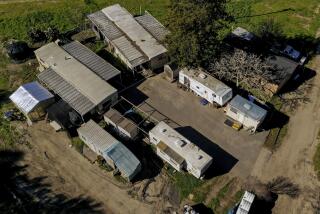Landscaping
- Share via
Labor costs are increasing for the landscaping industry as the minimum wage rises, the number of teen-agers and young adults in their early 20s drops and immigration reform restricts the availability of immigrant workers, industry officials and experts say.
Wages now start as high as $7.50 an hour for unskilled workers in Massachusetts and Connecticut, said Edward T. Wandtke, president of All-Green Management Associates, an industry consulting firm in Columbus, Ohio. “If there’s a struggle in the industry . . . it’s that they are all trying to keep their full-time employees.”
Year-round workers in California earn $7 or $8 an hour, and lead workers make $9 to $10 an hour, said Klaus Kumme, owner and president of Kumme Landscaping in Chatsworth. Trained foremen, who manage a project and even order some of the materials, are paid $14 to $18 an hour, he said.
Insurance costs are also rising for landscape architects and contractors. In the past several years, liability premiums have soared from as little as $300 a year for an architect to as much as $3,000, said Joe Heath, executive officer of the California Board of Landscape Architects, a state licensing agency.
Contractors are paying more too, primarily to shield themselves from lawsuits by workers injured on the job. Two years ago Kumme paid $1,800 for $300,000 in liability insurance. Now the premium is $6,400, and some developers want contractors to carry million-dollar policies, which would cost Kumme $7,500. “No one (customer) wants to pay double,” he said, “and yet insurance has quadrupled.”
Medium-sized contractors are feeling the worst crunch from rising insurance premiums and labor costs, experts agree. Big companies with a lot of cash can still afford to bid on large projects, while small companies can prosper by caring for homeowners’ lawns and gardens.
“You’re either small or you’re big. The in-between is a difficult place to be. That’s where I am. . . . One job gone bad can put you under,” said Kumme, whose firm has 12 employees and five trucks.
He added: “The (Immigration & Naturalization Service) and the insurance have put a squeeze on. We can’t raise our prices, and our costs have skyrocketed. . . . We’re in a hard place right now.”
Hiring a landscape architect to design a lawn, garden or entire suburban office block is not cheap. Rates in Southern California range from $20 to $150 an hour, said Rick T. Hume, president of the Southern California chapter of the American Society of Landscape Architects in Washington.
Landscape architects’ charges are reasonable considering the training required, Hume said. The California Board of Landscape Architects requires license applicants to take a test and have six years of combined educational and work experience. Seven bachelor’s degree programs and two master’s degree programs in landscape architecture are offered at state universities, Heath said. Only the head architects in a firm need licenses.
“When all is said and done,” said Betsy A. Cuthbertson, director of government affairs for the American Society of Landscape Architects, “a landscaper’s rates look pretty much like a lawyer’s rates.”
California’s landscape architecture profession is becoming more influential in the United States and overseas. The field has its U.S. roots in New York City, where industry pioneers Calvert Vaux and Frederick Law Olmsted designed Central Park in the late 1850s. But California now has about 2,000 licensed landscape architects, and the state’s total has doubled in the past 10 years, Heath said. There are only about 18,000 practicing landscape architects in the country, Cuthbertson said.
Forma, a Newport Beach landscape architecture firm, is designing a resort community, complete with hotel and golf course, in Tai Chung, Taiwan, said Hume, a principal in the company.
Golf courses make up a big chunk of the landscape industry’s annual revenues. Just maintaining the nation’s 13,407 golf facilities costs about $2.5 billion last year, according to the National Golf Foundation in Jupiter, Fla.
California leads the nation with 740 facilities, each of which may consist of one or more golf courses. Florida is second with 734, and New York is third with 731.
More to Read
Inside the business of entertainment
The Wide Shot brings you news, analysis and insights on everything from streaming wars to production — and what it all means for the future.
You may occasionally receive promotional content from the Los Angeles Times.










